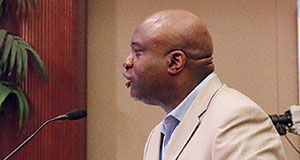
In hopes of gaining the City Council’s support during its Wednesday, February 15, meeting, the Apopka Community Task Force on Violence presented a document that the group called a community biopsy, urging for a five-pronged approach to solving violence in the area, especially in South Apopka.
First unveiled in December 2016 at a press conference, the task force report calls for the following: improved community safety, improved relationships between law enforcement and community residents, improved environment of the development of employability skills, more available jobs, and improved educational and vocational opportunities.
The Apopka Community Task Force on Violence had about 17 members including local law enforcement officers, area pastors, local students, and other community members.
The group was founded and held workshops on community solutions in early 2016 after several incidents of gun violence occurred in South Apopka. Bethune-Cookman University students, under criminal justice professor Dr. Randy Nelson’s leadership, facilitated the workshops.
Love said the task force’s focus was on looking at the root cause of violence and crime in the community, which is poverty, he said. The task force researched various crime statistics, especially in Apopka and Orange County.
“We’ll never be in a situation in which we’ll be able to law enforcement our way out of a situation we’re in,” said Apopka businessman Rod Love. “We address the root cause of violence and crime, and the root cause … is poverty.”
The task force is seeking state funding to address juvenile delinquency prevention, child welfare, and economic development, Love said. The group withdrew the 20 percent match from local governments on these bills.
Dr. Nelson explained that a relationship between law enforcement and the community must be developed, in which both sides can build reciprocal trust and accountability. He also discussed a correlation between poor educational opportunities and crime.
“Crime is a symptom, not a cause,” Nelson said.
Noticing that some of South Apopka lies within the designated Community Redevelopment Area (CRA) south of U.S. Highway 441, the task force said there is available money from the state for business growth and affordable housing in CRAs, including the one where South Apopka is located, according to attorney Greg Jackson.
The Community Redevelopment Agency adopted the first Community Redevelopment Plan in June 1993. Under state law, local governments can identify a CRA District if that region has needs such as more affordable housing, improved infrastructure and buildings, and increased roadways and parking space.
City Commissioners and Mayor Joe Kilsheimer expressed gratitude for the task force’s presentation and the work the group poured into putting the report together. Each City Council member commented on the report.
An expanded version of this story can be found on page 1A of the Friday, February 17, issue, of The Apopka Chief.
